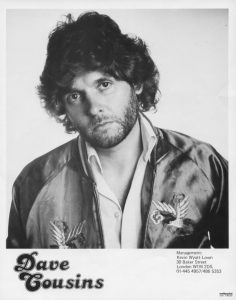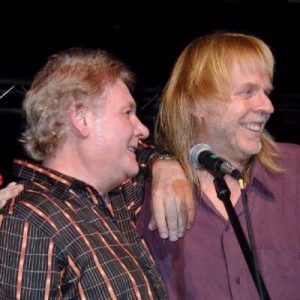HIT CHANNEL EXCLUSIVE INTERVIEW: January 2018. We had the great honour to talk with a great musician: Dave Cousins. He is best known as the founding member, vocalist and guitarist of Strawbs, a legendary progressive rock band. Past members of Strawbs include Rick Wakeman (Yes -keyboards) and Sandy Denny (Fairport Convention -vocals). They just released their latest album, “The Ferryman’s Curse”, which I find it great. Read below the interesting things he told us:
 Are you enjoying the current “Chapter & Verse” tour in the United States?
Are you enjoying the current “Chapter & Verse” tour in the United States?
It’s a very nice experience. We haven’t been here for 18 months and it’s a time when feelings can change, but their reaction to the new songs and the old songs that we play in this tour, is absolutely remarkable.
How important was Chris Tsangarides’ (Judas Priest, Thin Lizzy producer) contribution to “The Ferryman’s Curse” album?
Chris Tsangarides is a very interesting person (ed: we did this interview on 17 November, before his death). He has worked as a producer with big names like Black Sabbath, Thin Lizzy and many others. He contributed his vast experience and also he’s very sensitive. He’s not just a heavy metal producer, he’s a very sensitive person. Although he wasn’t involved with the songwriting, he tried very tactfully to help the members of the band, whether it was about a solo or while they were playing a part with their sound. He helped them remarkably. He is one of the best producers I have ever worked with.
“The Ferryman’s Curse” is the most ambitious composition of the album. Do the lyrics describe the killing of the Death?
“The Ferryman’s Curse” is the sequel to the song “The Vision of the Lady of the Lake” from the “Dragonfly” album, 45 years ago (ed: 1970). This song was written when I was in Lecce, Italy. I had the idea about this song in my head for a couple of days. Then, I sat by the swimming pool in the villa where the song was written, in Lecce. Later, I had to write three more verses to make the song more complete. It’s one of the best things we have ever done.
 How did you come up with the idea of adding bouzouki to the song “Bats & Swallows”?
How did you come up with the idea of adding bouzouki to the song “Bats & Swallows”?
That was the idea of Dave Bainbridge (keyboards, guitar). When the song was put down Dave Bainbridge played piano, but the piano didn’t sound right. Then, Dave tried the piano lines he played, on bouzouki and we took the piano out. And bouzouki has this glorious sound. So, it’s very much Dave Bainbridge on this funny instrument. But this song was written after a holiday I had on the island of Crete. I stayed in a tiny village, not far from Agios Nikolaos. I went there and I had a remarkable holiday. We had a swimming pool in this village and in the morning the swallows were flying up and down in the olive trees and were drinking water from the swimming pool and at night, the bats did exactly the same. The bats came and they were flying very low. That’s why the song is called “Bats & Swallows”. I met an old lady there in the village and her name was Irene. So, I got my guitar out and I sang an old Lead Belly song called “Goodnight Irene” and tears were flowing down her cheeks. That song is recorded as a tribute to this experience I had in this village in Crete.
What is the difference between and an electric Strawbs concert and an acoustic one?
They are two different worlds. The electric shows are very powerful and very vibrant and there’s too much at stake for our story. Otherwise, the acoustic shows are very much in the history in the band, not since the beginning, we do them when we can. But there are two completely different shows, the material is different. Very few songs played on that set are in common. So, they are two different shows, two different styles of Strawbs.
“Fingertips” (1970) is my favourite Strawbs song. What was the inspiration for this song?
I had a young lady with long blond hair, in Gothenburg, her hometown. We sat beside the lake, and that’s the history of this song: The drivers lied sticking around and I imagined her hair as the weeping willow, because she had beautiful hair. She had long blonde hair, she was very beautiful and that was the last time I saw her.
What memories do you have of the Queen Elizabeth Hall concert on 11 July 1970?
It was the first major concert we all had ever been. We were very excited. It was the first time we had done a show with Rick Wakeman.
 Are you proud that “Hero and Heroine” (1974) is considered a classic album?
Are you proud that “Hero and Heroine” (1974) is considered a classic album?
Yes, Rolling Stone put it among the 50 greatest progressive rock albums of all time. I’m very proud of that achievement. I think the album still stands out. It’s very good indeed. In my opinion, the second half of the album, is probably the best part, although we had the song “Autumn” on the first half. The album tells the story of a hero who was brought down by the heroine.
The same day you finished the song “The Hangman and the Papist” (1971), Roy Harper finished his song “Me and My Woman” in the same van. How did your relationship evolve?
It was very interesting because we were touring together and we were travelling in the same van. I was writing my song the same time as Roy was writing his song. When we stopped outside the place we were going to play, he said that he wanted to read my song and he said to me: “I would never write a song like that”. I said: “I can’t write a song like yours”. Although he said that he didn’t like my song, I loved his song. When we toured together years later, we had a great time. Now, we have a great deal of respect to each other.
What special Rick Wakeman (Yes) brought to the band when he joined?
It was very interesting when he joined, because although he was a pop player, he was a primarily classically-trained piano player. When we started playing together, I started to play a song on a primarily open tuning. Rick said: “You can’t play this. Play me the intro of the song”. He said: “That’s a dischord. You can’t play this”. I said: “That’s our sound”. He would play a note and not a chord. That was the development of Rick Wakeman’s style of playing. Then I’d sing as he was playing piano and that sounded great.
 What is the secret of you lasting friendship with Tony Visconti (David Bowie, T. Rex, Thin Lizzy producer)? Dο you have happy memories of the albums you made together?
What is the secret of you lasting friendship with Tony Visconti (David Bowie, T. Rex, Thin Lizzy producer)? Dο you have happy memories of the albums you made together?
Tony Visconti says that the “Dragonfly” (1970) album he made with us, is one of the top 6 albums he has produced. Two are by David Bowie, “Heroes” and “Blackstar”, one by T. Rex, one by Morrissey, another one by Gentle Giant and then our album. We worked together for the first time on “Dragonfly” album and we remained friends ever since. Last time I saw him was five years ago in London. He was producing an album for a young girl (ed: Debbie Clarke), who covered my song “Lay Down”.
Can you imagine how it would be if Sandy Denny (Fairport Convention –vocals) had stayed with the band?
I think had she stayed with us, we would have a couple of hit singles because the songs on that album we played are very slow, especially the older songs that we wrote. We had a couple of pop songs and I think Sandy would eventually leave the group anyway and she probably would join Fairport Convention later.
How did it happen to meet Salvador Dali twice?
We first played in Paris with Rick Wakeman at the Rock ‘n’ Roll Circus. It was a circus tent with circus artists and the musicians and the bands had to accompany circus acts. We were accompanying the high wire act, the man of the high wire act in a forward roll and Rick had to play a solo to accompany that. During his solo, Salvador Dali jumped on stage, waving his stick in the air. The audience went crazy, but Rick Wakeman said: “Who the fuck is that?” I said: “Salvador Dali”. He said: “I don’t care who the fuck he is, get him off!”The next time I saw Salvador Dali was in the reception of the St. Regis Hotel in New York. Salvador Dali tapped me on that shoulder and said: “I love your boots”. I was wearing very expensive handmade Japanese leather boots that were silk screen printed very beautifully. He said: “I love your boots” and he gave me a bottle of wine. I shook his hand.
 Do you think social media like Youtube and Facebook have helped younger listeners to learn about the music of Strawbs?
Do you think social media like Youtube and Facebook have helped younger listeners to learn about the music of Strawbs?
I think so. What is happening now, is that when people come to our shows, they bring their children. The older men didn’t write on Facebook, but the younger come with their parents to see our shows and then they write on Facebook. That’s very important. The other important source is Youtube. A lot of people watch our live videos on Youtube.
How emotional was it to write your autobiography “Exorcising Ghosts” (2014)?
It took me 18 months to write it. I wrote it all longhand with a pencil and a rubber, I transcribed it on myself on my computer, then I edited it with myself, I chose all the photographs and in the end I gave it to one person to check it through to make sure what I wrote was legally ok.
Was it a liberating experience to make your first solo album “Two Weeks Last Summer” (1972)?
It was an interesting experience. I had a lot of songs leftover that I wanted to do greatly and I decided to do them on my own. The first person I wanted was Jon Hiseman (Colosseum), the drummer, the other person I recruited was Roger Glover (Deep Purple), the bass player. These were very good rock players. Jon Hiseman was a drummer who could play plenty of things and Roger Glover was very much a rock bass player. I got Miller Anderson to play electric guitar, he was a superb slide guitar player. For the first time ever, I was playing with rock musicians on an album of new music. John Hiseman and Roger Glover played along great. This album is one of my favourite albums I have ever done.
Do you remember the interview with David Bowie on Denmark Radio in March 1971?
Yes, I remember it very well. David and I were very good friends at the time. We were introduced by Tony Visconti. David became very famous because of his mime on one of our songs, “Poor Jimmy Wilson”. David made his first ever television appearance with us on our show on Colour Me Pop (ed: 14 June 1969, one month before the release of “Space Oddity”).
 Did you have a good time when you toured with King Crimson and Frank Zappa?
Did you have a good time when you toured with King Crimson and Frank Zappa?
It was a very exciting time. We did many-many shows with King Crimson and we were very good friends with the band and they appeared to love what we did. Probably, they were the best double-headed shows we have ever played with. With Frank Zappa we only did one show and he was very kind. He produced a separate mix of our performance. He was very charming.
John Paul Jones (Led Zeppelin) played bass on the first Strawbs album (1969). What was he like? He’s one of my heroes!
He was a very young session player at the time. He was superbly talented. I was playing my guitar on open tuning and he knew exactly what I was planning to do. We were playing with Nicky Hopkins (ed: Rolling Stones, The Who session pianist) on most of the songs and it was absolutely amazing to have two of the best session players to play on the first track we ever recorded in the studio. We had recorded with Sandy Denny in Denmark on a 3-track cinema film. We were recording on 8-track for the very first time and that was where John Paul Jones played in. He was very nice on that and he went on to achieve greatness.
Do you think Strawbs should have been more popular?
It was at the top of our days when our management decided to leave our record label, A&M Records. We reached our peak with “Hero and Heroine” and “Ghosts” (1975) and then, after that our management decided to go different ways with A&M Records and our career never recovered from that.
 Are you happy with the comeback of the vinyl records?
Are you happy with the comeback of the vinyl records?
It’s remarkable what is happening. Our new album, “The Ferryman’s Curse” will come out on vinyl, but not until next year. We’ll bring enough of them in our concerts and that’s important for us.
Had you ever met Jimi Hendrix?
I think he was an astonishing guitar player. I saw him playing in a very-very small pub. No, I didn’t meet him.
A huge “THANK YOU” to Mr Dave Cousins for his time. I should also thank Anne Leighton and Billy James for their valuable help.
Official Strawbs website: http://www.strawbsweb.co.uk

